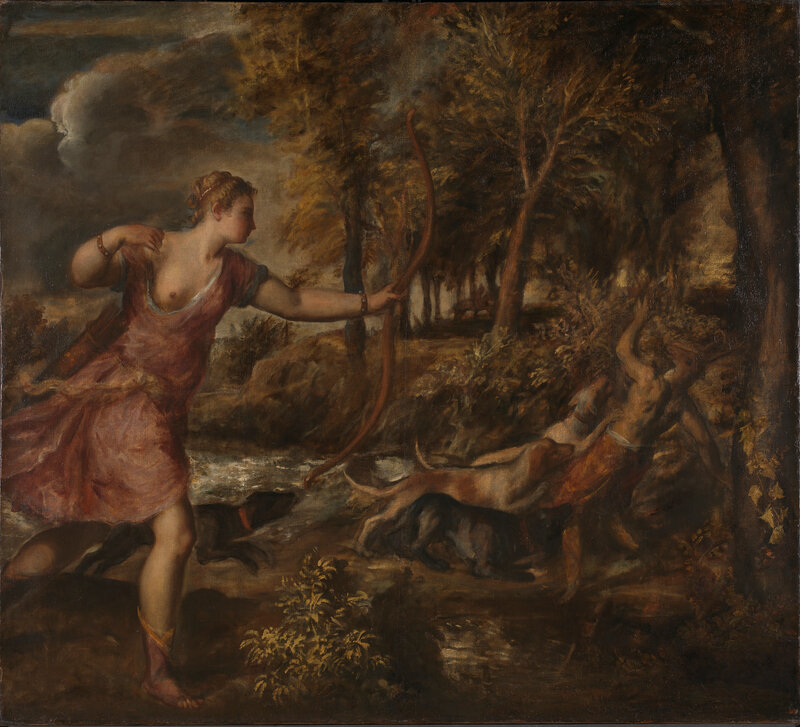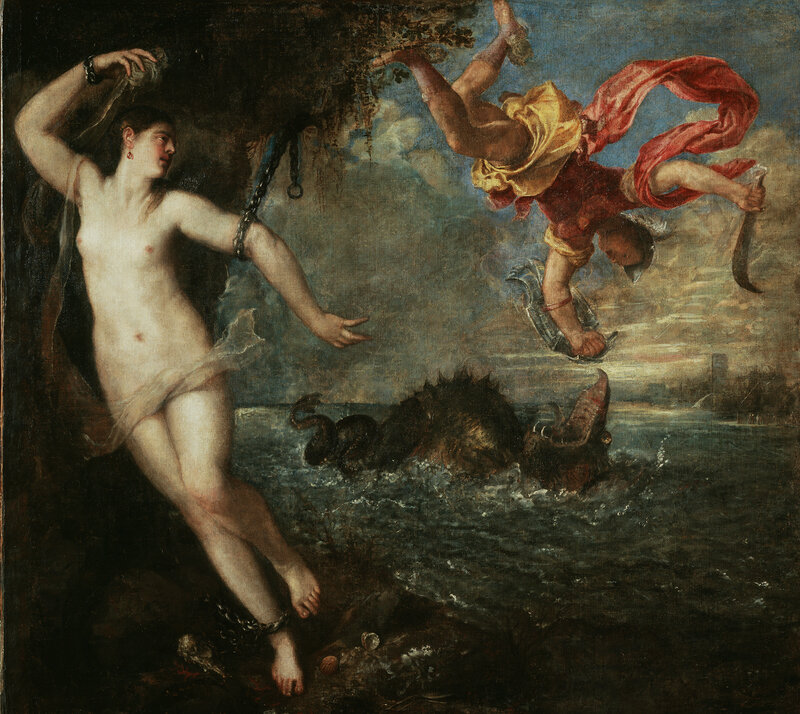'Titian: Love, Desire, Death' at the National Gallery, London
Titian’s epic series of large-scale mythological paintings, known as the 'poesie', will be brought together in its entirety for the first time since the late 16th century at the National Gallery next March.
From the original cycle of six paintings, the exhibition will reunite 'Danaë' (1551–3, The Wellington Collection, Apsley House); 'Venus and Adonis' (1554, Prado, Madrid); Diana and Actaeon (1556–9) and Diana and Callisto (1556–9), jointly owned by the National Gallery and the National Galleries of Scotland; and the recently conserved 'Rape of Europa' (1562) from the Isabella Stewart Gardner Museum, Boston.
Following its landmark decision to lend works on a temporary basis for the first time in its 119-year history, the Wallace Collection will lend its painting from the cycle, 'Perseus and Andromeda', (1554–6), to the exhibition in Trafalgar Square.
The National Gallery’s own Death of Actaeon (1559–75), originally conceived as part of the series, but only executed much later and never delivered, will also be displayed in London.
Painted between about 1551 and 1562 the 'poesie' are among the most original visual interpretations of Classical myth of the early modern era and are touchstone works in the history of European painting for their rich, expressive rendering.
All the paintings revolve around love and desire:, their fruits and perils. Combining Titian’s remarkable talent as both artist and storyteller, the mythological scenes capture moments of high drama; a fatal encounter, a shameful discovery, a hasty abduction. In these paintings Titian expertly manipulates paint and colour to dazzling effect; capturing luminous flesh, sumptuous fabrics, water and reflection, as well as atmospheric, almost enchanted, landscapes. His characters show very human, and relatable, emotions: euphoria, concern, guilt, surprise, shame, desperation, anguish, and terror.
The paintings depict stories from Classical mythology, primarily drawn from the Roman poet Ovid’s 'Metamorphoses'. Because he considered them visual equivalents to poetry, Titian called them his ‘poesie.’ He distilled in them the knowledge of painting and visual storytelling that he had acquired over five decades as an artist to create some of his most profound statements on human passion and irrationality, on love and death. The series was commissioned by Philip II of Spain, who highly unusually gave Titian an open brief to select his subjects.
Letters between Titian and Philip show that he conceived the 'poesie' to be displayed together in a single room but, since Philip was constantly changing residence during the course of their creation, it is unlikely that the patron was thinking of a specific destination for the group. The paintings are a prime example of a great artist in rare concert with a sensitive patron, continuing to grow and deepen his artistic outlook into his older years.
The commission was a turning point in Titian’s career. It provided him with an opportunity to deepen his skills at staging complex narrative, handling difficult and ambiguous emotion, and painting expressively to appeal to all five senses.
Titian, Diana and Actaeon, 1556-9. Oil on canvas, 184.5 x 202.2 cm. © The National Gallery London / The National Galleries of Scotland.
Titian, The Death of Actaeon, about 1559-75. Oil on canvas, 178.8 x 197.8 cm. © The National Gallery, London.
Of Titian’s six great 'poesie' for Philip II of Spain, only two remained in Madrid, Spain: 'Danaë' and 'Venus and Adonis'. 'Danaë' remained longer, but was taken by Joseph Bonaparte in 1813 and seized by Wellington in the Battle of Vitoria, after which it came to England. 'Venus and Adonis' was also in England, as Titian sent it to Philip when he was in London, having just married Mary Tudor (1516–1558).
Titian, Danae, about 1551–3. Oil on canvas, 114.6 × 192.5 cm, Wellington Collection, Apsley House, London. © Stratfield Saye Preservation Trust.
Titian, Venus and Adonis, about 1553-4. Oil on canvas, 186 × 207 cm, Museo Nacional del Prado, Madrid. © Photographic Archive Museo Nacional del Prado, Madrid.
The other four, 'Perseus and Andromeda', 'Rape of Europa', 'Diana and Callisto', and 'Diana and Actaeon', plus the unfinished 'The Death of Actaeon', passed by different routes into the collection of Philippe II, Duc d’Orléans (1674–1723). When this collection was auctioned in London in 1798, the five 'poesie' were divided but remained in British collections throughout the 19th century. 'Perseus and Andromeda' was unsold at the first sale, and then changed hands before being sold at the second Duc d’Orléans sale in 1805. All the 'poesie' have, therefore, been in the UK at some point, and 'Perseus and Andromeda' several times, first when Van Dyck brought it to London some time after 1623.
The outstanding quality of the 'poesie' inevitably attracted offers from wealthy collectors abroad and in 1896 the 'Rape of Europa' was sold to Isabella Stewart Gardner for her collection in Boston, USA . However, 'Perseus and Andromeda' was secured for Britain the following year as part of the Wallace Collection bequest. In 1972, when 'The Death of Actaeon' was offered for sale, the National Gallery successfully purchased the painting with the help of government funds and following a nationwide public appeal. In 2009, the National Gallery and the National Galleries of Scotland jointly acquired 'Diana and Actaeon'; and in 2012, 'Diana and Callisto', securing the last two of these masterpieces for the public.
Titian, Perseus and Andromeda, about 1554-6. Oil on canvas, 183.3 x 199.3 cm, The Wallace Collection, London. © The Wallace Collection, London / Photo: The National Gallery, London.
Titian, The Rape of Europa, 1559–62. Oil on canvas, 178 × 205 cm, Isabella Stewart Gardner Museum, Boston. © Isabella Stewart Gardner Museum, Boston.
Titian, Diana and Callisto, 1556-9. Oil on canvas, 187 × 204.5 cm. © The National Gallery London / The National Galleries of Scotland.
Dr Matthias Wivel, Curator of 16th-Century Italian Paintings at the National Gallery, and curator of 'Titian: Love Desire Death', says: 'For many lovers of painting, this is the realisation of a dream once thought impossible. The paintings are so powerful individually that I find it hard to overestimate the effect, finally, of seeing them together.'
Dr Gabriele Finaldi, Director of the National Gallery, says: 'Unthinkable until today, for the first time in over four centuries, now thanks to the Wallace Collection’s loan of the Titian 'Perseus and Andromeda', all of the artist’s late ‘poesie’ mythologies will be seen together.'
Matthew Moore, President and Managing Director, Liberty Specialty Markets, says: 'We are proud to be supporting the exhibition. We are one of the leading global providers of specialty insurance cover for Fine Art and Specie collections. We understand how important it is to preserve and care for these pieces of history so that we can enjoy them and so can future generations. This is a once in lifetime opportunity to be able to see all six paintings in one place and I am very much looking forward to enjoying them.'
The exhibition will travel to the Scottish National Gallery, Edinburgh (11 July – 27 September 2020), the Prado, Madrid (20 October 2020 – 10 January 2021), and the Isabella Stewart Gardner Museum, Boston (11 February – 9 May 2021). 'Perseus and Andromeda' is confirmed only for London at present.
The exhibition is curated by Dr Matthias Wivel, Curator of 16th-Century Italian Paintings at the National Gallery, London.
Exhibition organised by the National Gallery, the National Galleries of Scotland, the Museo Nacional del Prado, and the Isabella Stewart Gardner Museum, Boston.
16 March – 14 June 2020

/https%3A%2F%2Fprofilepics.canalblog.com%2Fprofilepics%2F1%2F0%2F100183.jpg)
/https%3A%2F%2Fstorage.canalblog.com%2F03%2F02%2F119589%2F96711876_o.jpg)
/https%3A%2F%2Fstorage.canalblog.com%2F11%2F31%2F119589%2F94773502_o.jpg)
/https%3A%2F%2Fstorage.canalblog.com%2F20%2F83%2F119589%2F94772815_o.jpg)
/https%3A%2F%2Fstorage.canalblog.com%2F26%2F72%2F119589%2F75604929_o.jpg)
/https%3A%2F%2Fstorage.canalblog.com%2F59%2F60%2F119589%2F26458628_o.jpg)










/image%2F1371349%2F20240412%2Fob_258f9b_ash-ashm-wa2008-89-001.jpg)
/image%2F1371349%2F20240412%2Fob_d5ebdf_10105187116-db17b2f5ff-b.jpg)
/image%2F1371349%2F20240412%2Fob_efd409_dp811857.jpg)
/http%3A%2F%2Fstorage.canalblog.com%2F04%2F81%2F119589%2F128791640_o.jpg)